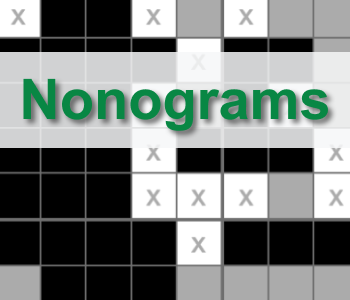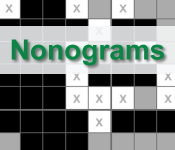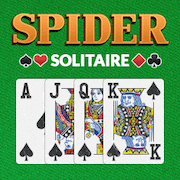Nonograms game info
Rules
In Nonograms, the cells in the grid have to be colored according to the clues at the top and left of the grid.
The clues provided next to each row and column indicate the lengths of consecutive filled cells (blocks) in that row or column. These blocks must appear in the order of the clues.
There must be at least one blank cell separating consecutive blocks.
The puzzle is complete when all clues are satisfied.
If you are sure a cell will be blank, it can be marked with an x. This can help in completing the puzzle.
Puzzle sizes
The Nonogram puzzles on our website come in 4 sizes: 10x10, 15x15, 20x20, and 25x25.
For each of these sizes, there is a daily puzzle you can solve.
Tips and tricks
- Start with the highest clues: Start with the rows and columns that have the highest clues, these will allow to fill more cells.
- Mark obvious fills: If a row is 15 squares wide and the clue is "15", fill the entire row. Or if the clue is “6 8” you can also fill the entire row.
- Calculate overlaps: For clues that span most of the row or column, calculate overlaps. For example, if a row is 10 squares wide and the clue is "8", at least the middle 6 squares are guaranteed to be filled.
- Mark empty squares: Mark definite empty squares to help you visualize where groups cannot go. If you complete all groups in a row/column, mark the remaining squares as empty.
- Switch direction: If you are focusing on completing rows and get stuck, it can help to switch to completing columns for a while, because there will be new information.
- Complete edge groups: If a cell on the edge of the grid is filled, you can complete the whole group it belongs to, as the group can only extend to one direction.
- Extend edge groups: If the first group in a row has length 5 and the third cell in the row is filled in, you know that the fourth and fifth cell will also belong to the group.
- Practice: Start with smaller grids (e.g. 10x10) to build understanding. As you improve, move to larger or more complex puzzles.
Controls
Click or tap on an empty cell to fill it. Click or tap again to mark the cell with an x. Click or tap again to empty the cell again.
It is also possible to click and drag across multiple cells.
There are some shortcuts that can be used on the computer: Undo (Z), Redo (Y), Reset puzzle (R), Save (S).
Origin
Nonogram puzzles have their origins in the late 1980s in Japan, where they were created independently by two designers: Non Ishida and Tetsuya Nishio.
Non Ishida, a Japanese graphics designer, is often credited with inventing the concept in 1987 when she won a contest to design a new type of logic puzzle. Her idea was inspired by creating grid-based designs using lights on skyscrapers, which led to the development of puzzles where solvers would shade in cells on a grid to form a hidden image.
Around the same time, Tetsuya Nishio came up with a similar concept. His puzzles were published in a different magazine, and they quickly gained popularity due to their unique combination of logic and artistry.
Other names
In 1990, James Dalgety from the UK invented the name Nonograms, deriving it from one of its inventors "Non”.
Nonogram puzzles are known with many different names, for example: Hanjie, Paint by Numbers, Crosspix, Griddlers, Pic-a-Pix, Picross, Edel, Japanese Crosswords, Logimage.
Similar games
Another logic puzzle game on our site in which the grid has to be filled with black and white cells is Nurikabe.
System requirements
Nonograms can be played in all modern browsers, on all device types (desktop, tablet, mobile), and on all operating systems (Windows, macOS, Linux, Android, iOS, ...).
Classification: Home ›
Classic ›
NonogramsRating: 74% (53 votes)
Inventor: Non Ishida & Tetsuya Nishio
Developer: SolitaireParadise
Technology: HTML5
Wiki's: Wikipedia















